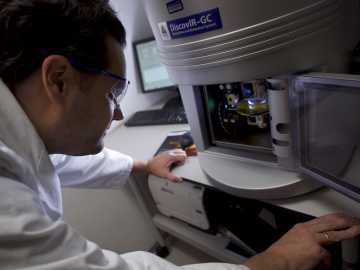Researchers may finally have created hydrogen metallic
ShareResearchers may finally have created hydrogen metallic

Scientists have been trying to produce hydrogen-metal for decades, but nobody has managed to demonstrate incontrovertible evidence of success yet. A team of researchers from the Atomic Energy Commission of France is the latest to lay claim to the success through a document published on the server arXiv on-line. The scientists used a new type of test chamber of high pressure to squeeze out the hydrogen until it is moved to the legendary hydrogen metal. If true, this could help to advance planetary science and lead to new materials.
Hydrogen is the most common element in the universe: it feeds the nuclear fusion in the stars and floats through the cosmos in huge clouds. However, the behavior of the hydrogen as a gas and plasma are understood relatively well. Scientists have never been able to study the hydrogen-metal near it because it has been purely theoretical. The physicist Eugene Paul Wigner predicted the existence of the hydrogen-metal for more than 80 years, and scientists now believe that they form the core of gas giants like Jupiter.
The hydrogen-metal is what it seems, a form of hydrogen that has the electronic and optical properties of a metal. The researchers point out that many elements can become metallic when subjected to sufficient pressure. For example, the oxygen becomes a metal at around 100 Gpa. That is a million times greater than the atmospheric pressure of Earth.
A team from Harvard claimed to have created hydrogen metal in 2017, but that sample later disappeared without explanation. Paul Loubeyre, who led the new research, was openly skeptical of the announcement of the 2017. Your team of the Atomic Energy Commission apparently used a diamond-anvil cell with a new design toroidal to place samples of hydrogen under increased pressure.
The team first created a molecular hydrogen solid by subjecting the hydrogen gas to 310 Gpa of pressure. As the pressure slid higher, bombarded the sample with infrared radiation of the synchrotron SOLEIL (a particle accelerator French). 425 Gpa and 80 degrees above absolute zero, the properties of the sample changed. He began to absorb all of the infrared radiation, indicating that the electron could move freely through the hydrogen now metallic.
These results have not yet been peer-reviewed, but the initial reaction to the document is more positive than the announcement of 2017. Other researchers will take months to review the results and confirm the findings independently. If this really is hydrogen a metal, the researchers could learn more about the inner workings of gas giants and perhaps even produce new superconducting materials.
Hydrogen is the most common element in the universe: it feeds the nuclear fusion in the stars and floats through the cosmos in huge clouds. However, the behavior of the hydrogen as a gas and plasma are understood relatively well. Scientists have never been able to study the hydrogen-metal near it because it has been purely theoretical. The physicist Eugene Paul Wigner predicted the existence of the hydrogen-metal for more than 80 years, and scientists now believe that they form the core of gas giants like Jupiter.
The hydrogen-metal is what it seems, a form of hydrogen that has the electronic and optical properties of a metal. The researchers point out that many elements can become metallic when subjected to sufficient pressure. For example, the oxygen becomes a metal at around 100 Gpa. That is a million times greater than the atmospheric pressure of Earth.
A team from Harvard claimed to have created hydrogen metal in 2017, but that sample later disappeared without explanation. Paul Loubeyre, who led the new research, was openly skeptical of the announcement of the 2017. Your team of the Atomic Energy Commission apparently used a diamond-anvil cell with a new design toroidal to place samples of hydrogen under increased pressure.
The team first created a molecular hydrogen solid by subjecting the hydrogen gas to 310 Gpa of pressure. As the pressure slid higher, bombarded the sample with infrared radiation of the synchrotron SOLEIL (a particle accelerator French). 425 Gpa and 80 degrees above absolute zero, the properties of the sample changed. He began to absorb all of the infrared radiation, indicating that the electron could move freely through the hydrogen now metallic.
These results have not yet been peer-reviewed, but the initial reaction to the document is more positive than the announcement of 2017. Other researchers will take months to review the results and confirm the findings independently. If this really is hydrogen a metal, the researchers could learn more about the inner workings of gas giants and perhaps even produce new superconducting materials.
Keywords: hydrogen, pressure, new, metal, researchers, hydrogen-metal, team, gas, sample, Gpa, form, materials, Paul, Scientists, properties, metallic, scientists, created, announcement, infrared